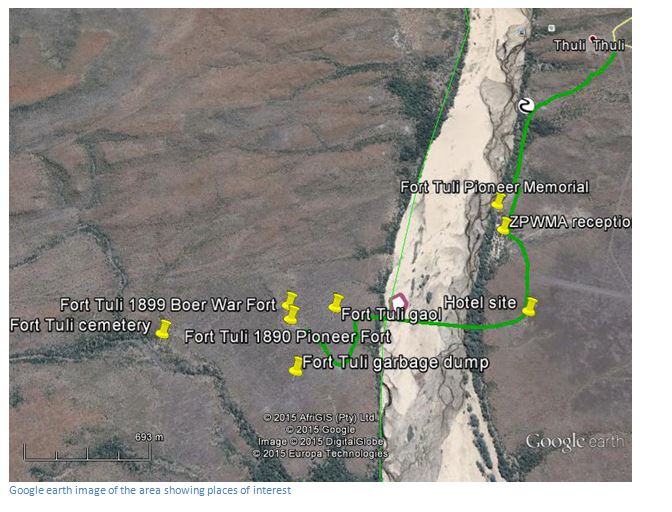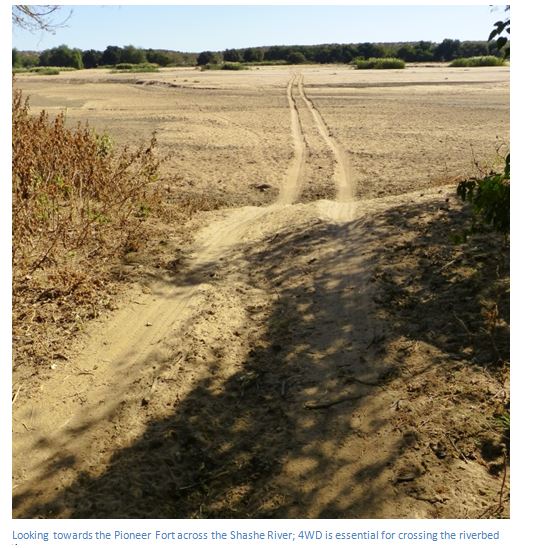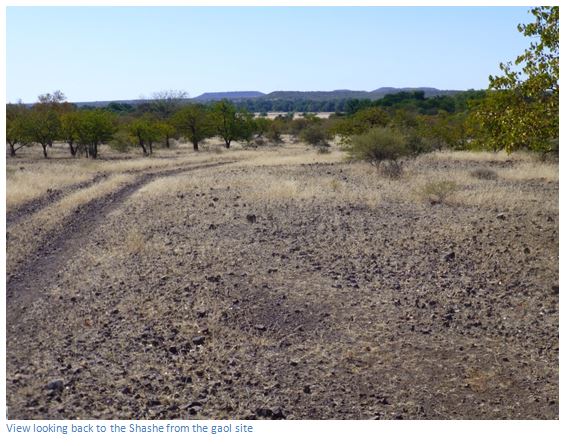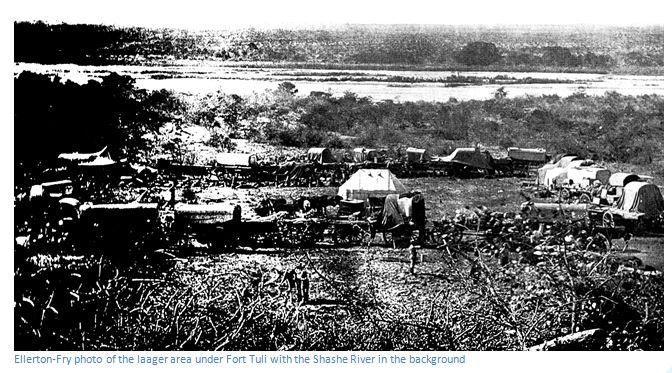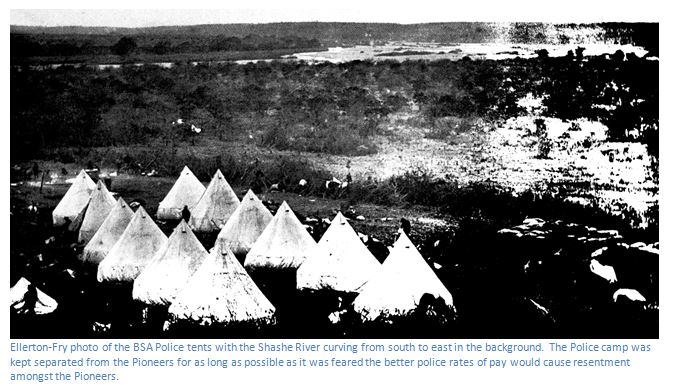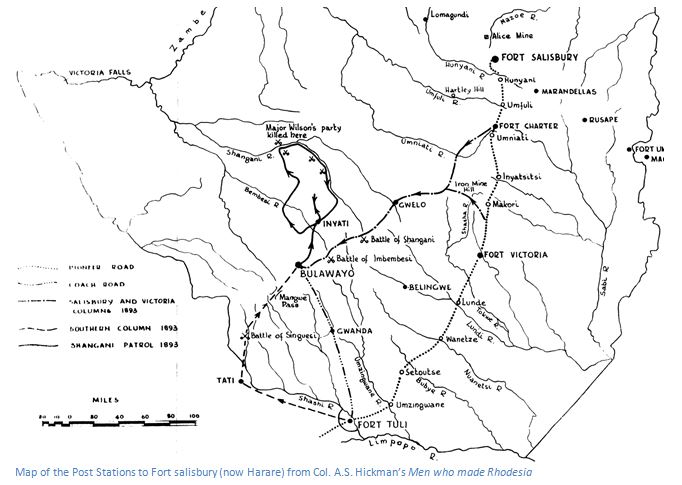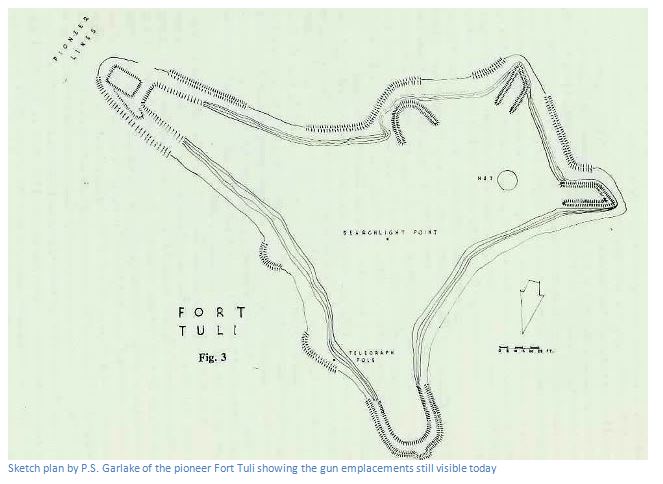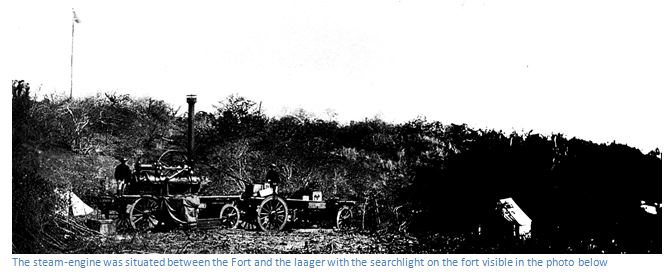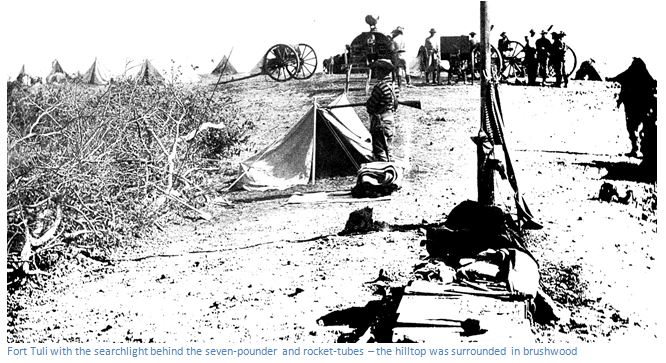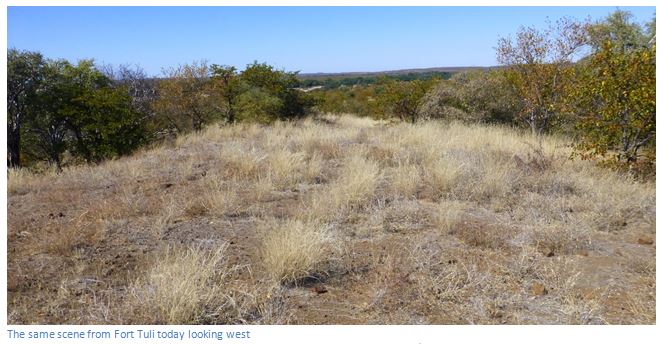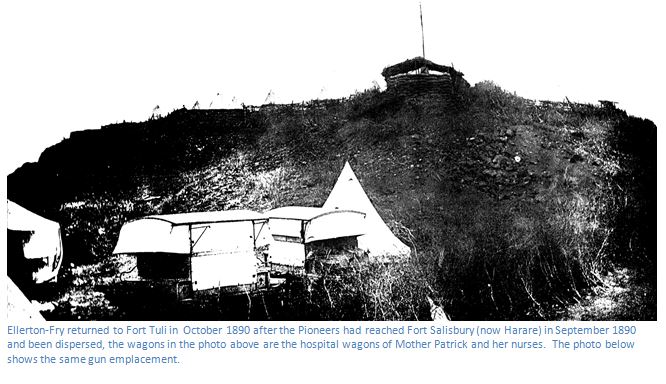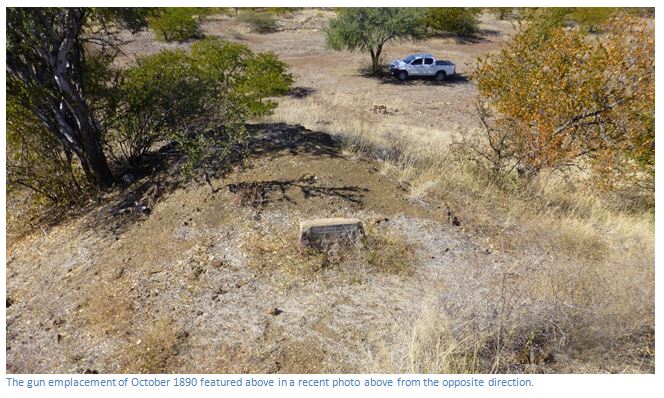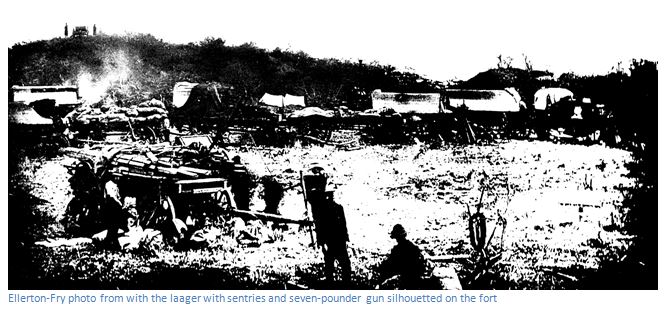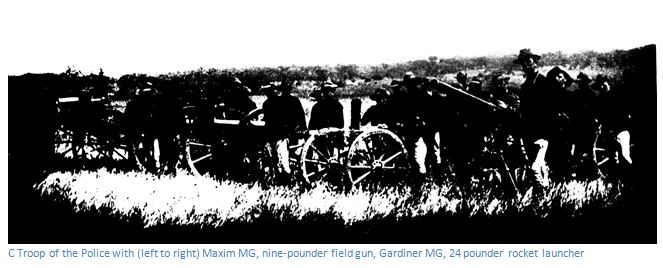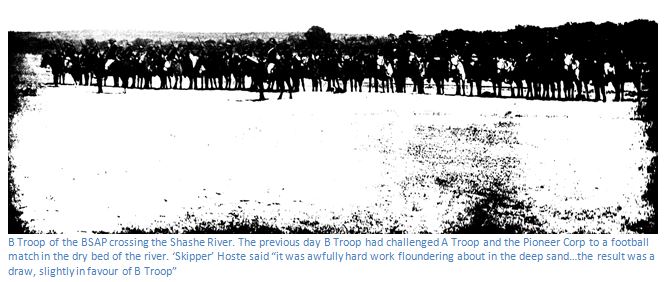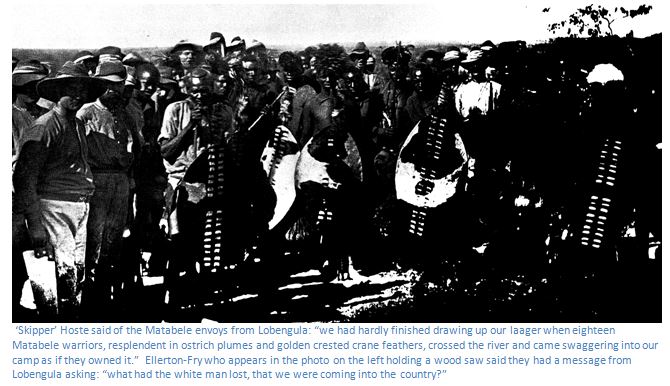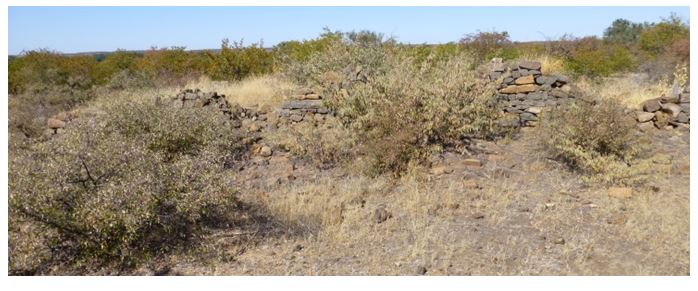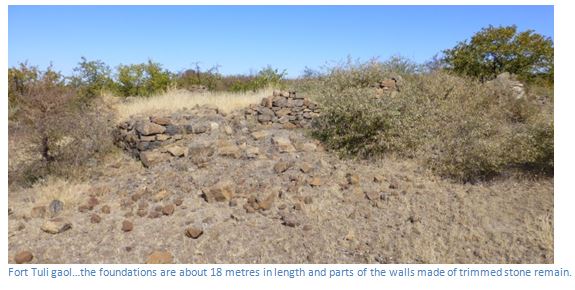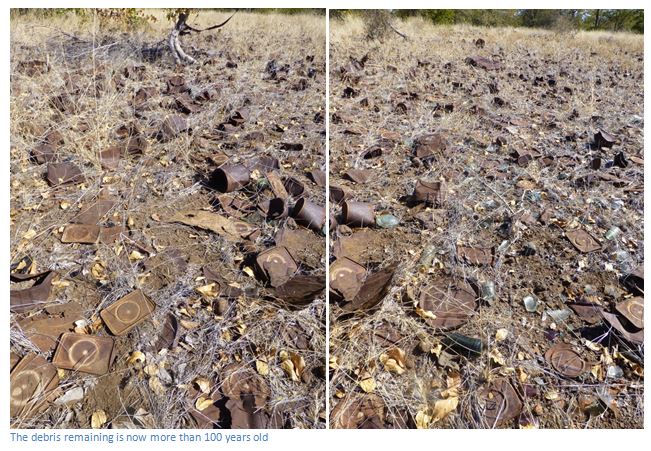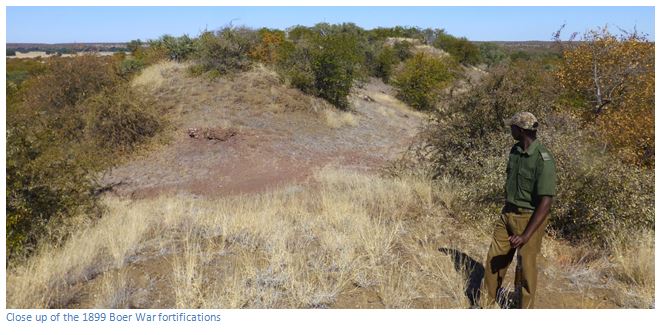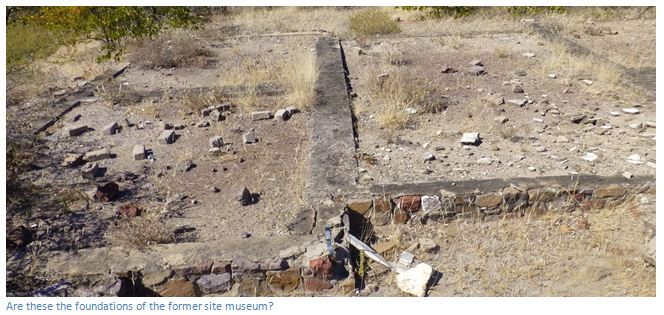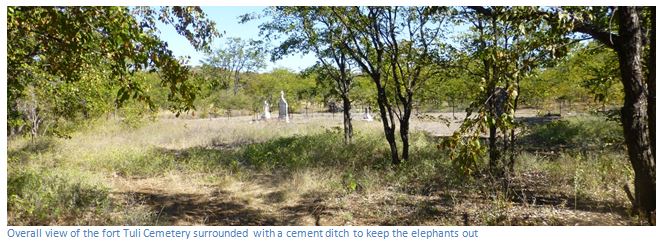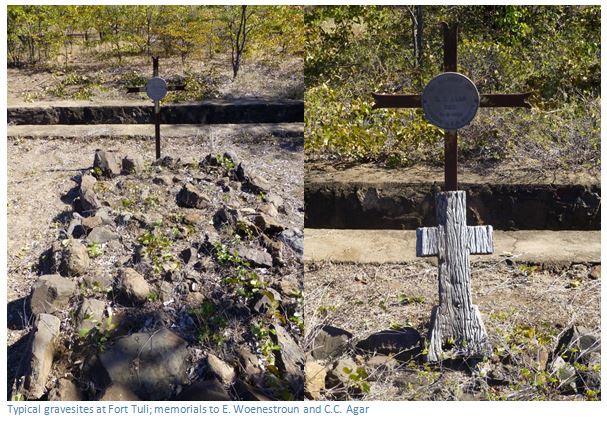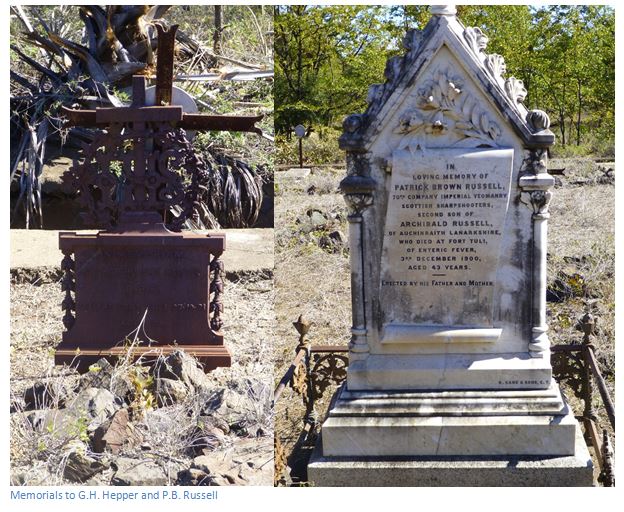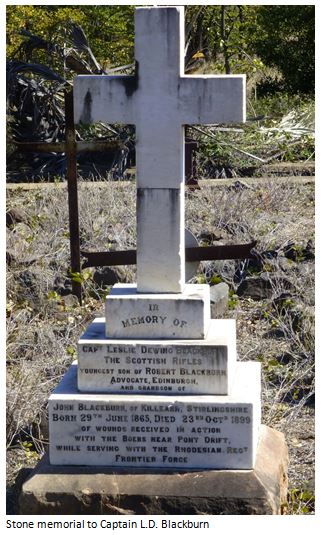Fort Tuli
- Historic site where the British South Africa Company set up its rear base for the occupation of Mashonaland and from where the Pioneer Column left on 11th July 1890 and raised the flag at Fort Salisbury (now Harare) on 13th September 1890.
- The 1899 Boer War fortifications are slightly north of the 1890 Pioneer Fort and comprised outer trenches and defensive walls and gun emplacements.
- Fort Tuli was present at the birth of Rhodesia (now Zimbabwe) with the principal players being the Imperial Government, Cecil John Rhodes and the Charter Company who were funding the operation, the Boers to the south in the Northern Transvaal (now Limpopo) the Portuguese in Manicaland and the Matabele under their King, Lobengula. Britain’s move into Bechuanaland in 1855 set in motion all the forces thus positioned in 1890.
- At the time few thought the Pioneer Column’s entry into Mashonaland would go unchallenged by Lobengula’s Regiments given the opportunity and so the Pioneers were protected by the Police Troops who were placed under military discipline whilst on the march and their supply line protected by the forts erected at Tuli, Victoria (now Masvingo) Charter and Salisbury (now Harare)
From Harare at the junction of the A6 / A4 at Beitbridge take the A6 Beit Bridge to Bulawayo road for 5.3 KM and turn left at sign which reads Kuduland River Lodge and Nottingham estate HA-BANGALA. At 11.3 KM cross the Bertie Knott Bridge over the Umzingwane and immediately after turn right, 18.2 KM continue left at the junction and signposts for Nottingham Estate and green / yellow Tuli Safari Area sign Nottingham Estate, 23.7 KM pass the Kuduland sign on the left, 28.9 KM pass the Fishing Camp sign on the right. 38.1 KM keep right at the junction, 31.2 KM pass the ECM disused coal mine on the right, 42.2 KM pass the fly camp turnoff on the right, pass citrus fields, 57.2 KM pass entrance to Sentinel Ranch on the left. Continue travelling west, 109 KM reach Shashe Business Centre; 132 KM reach Limpopo Business Centre. Take the road north, 137 KM reach a junction which has a green / yellow sign saying department of parks and Wildlife – Tuli Safari Area and turn left, 150 KM reach Tuli Police camp. Turn left at the sign saying Aerodrome / Tuli Safari Area, 151.5 KM turn right into ZWMA camp, 152.3 KM reach National Parks office and check-in.
From Bulawayo after exiting Gwanda continue on the A6 for 6 KM and turn right onto the tarred Guyu Road signposted with a green / white sign with Tuli Institute. At 24.9 KM continue straight on, 43.4 KM continue straight on, 57.5 KM reach Guya Business Centre and Police Station. The tar road changes to gravel, 105 KM continue straight on, 112.2 cross stream, 123.8 KM cross stream, 127.4 KM cross stream, 133.2 KM reach Tuli Police Camp, follow the sign saying Aerodrome / Tuli Safari Area, 134.7 KM turn right into ZWMA camp, 135.4 KM reach National Parks office and check-in.
NOTE: The Shashe River crossing is about 600 metres of sand and requires 4WD to get across.
GPS reference for 1890 Pioneer Fort: 21⁰55′51.25″S 29⁰10′32.30″E
GPS reference for 1899 Boer War Fort: 21⁰55′48.54″S 29⁰10′32.66″E
GPS reference for the cemetery: 21⁰55′46.53″S 29⁰10′05.69″E
GPS reference for garbage dump: 21⁰56′01.05″S 29⁰10′30.33″E
GPS reference for the gaol: 21⁰55′51.59″S 29⁰10′42.03″E
GPS reference for the Hotel site: 21⁰55′03.56″S 29⁰11′21.03″E
The British South Africa (BSA) Company was granted its Royal Charter on 29th October 1889 and included Clause 10 giving authority for the formation of a police force: “The Company shall to the best of its ability preserve peace and order in such ways and manners as it shall consider necessary, and may with that object make ordinances (to be approved by our Secretary of State) and may establish and maintain a force of police.”
Colonel Sir Frederick Carrington, commanding the Bechuanaland Border Police (BBP) took charge recruiting the new force that were initially based in Bechuanaland (now Botswana) and recruiting was undertaken by William Bodle, the Regimental Sergeant-Major of the BBP with recruits coming by ox-wagon from Kimberley through Taungs and Vryburg to Mafeking where they assembled.
Sir Henry Loch, the British High Commissioner for South Africa, decided the Pioneer Column then being recruited by Frank Johnson needed an adequate escort to accompany them and guard their lines of communication at the BSA Company’s expense. The initial extra men of the BBP thus became the core of the BSAP with up to 500 men to be recruited.
In April 1890, the British South Africa Police (BSAP) built a pentagonal earthwork fort at Matlaputla, designed by McAdam of the BBP, one kilometre south of the Macloutsie River. The main base camp for the Pioneer Column for supplies and training was at Macloutsie, 40 kilometres further east in the disputed territory claimed both by Khama and Lobengula. The Troop leaders were:
BSAP Troop | Commanding Officer |
A | Capt. H.M. Heyman |
B | Capt. P.W. Forbes |
C | Capt. C. Keith-Falconer |
D | Capt. E.C. Chamley-Turner |
E | Capt. Tomkins, then Capt. A.G. Leonard |
F | Capt. C.F. Lendy, the artillery group |
In May 1890, General Methuen, Adjutant-General of British Forces in South Africa inspected the men at Macloutsie and gave them approval to deploy.
A few months later, in July 1890, Fort Tuli was built by the Pioneer Column and by “A” Troop of the BSAP. Initially named Fort Selous, as Frederick Courtenay Selous used the site as a base for some of his hunting expeditions, the Fort was soon re-named Fort Tuli, although it is actually on the Shashe River with the Tuli River joining the Shashe River some 17 kilometres upstream of the Fort. Ellerton-Fry, whose album many of the following photographs are taken from, labels the Shashe River as the Tuli River throughout his album, so it was presumably a common misconception. Fort Tuli was built over 500 metres from the Shashe River at a site which attracted criticism at the time as the perimeter of the hill was too wide to be properly defended by the small garrison available. However, there are extensive views of the surrounding bush country and the Shashe River drift and the site would have proved difficult for Lobengula’s Regiments to attack.
On 11th July 1890 the Pioneer Column crossed the Shashe River at Fort Tuli and entered Mashonaland skirting east to avoid Matabeland. D Troop initially garrisoned Fort Tuli with E Troop at Macloutsie; but from 15th December 1890 E Troop under Capt. A.G. Leonard were stationed at Fort Tuli.
Col A.S. Hickman in Men who made Rhodesia believes it was good communications that were the key to the occupation of Mashonaland and they were operated entirely by the BSA Police. Initially before the telegraph line arrived at Fort Tuli, there was a heliograph signalling system that flashed sunlight onto a mirror using Morse code; the flashes are produced by momentarily pivoting the mirror, or by interrupting the beam with a shutter. This was operated by the BPP for 190 kilometres between Palapye and Macloutsie and the BSAP for the 100 kilometres to Fort Tuli. From Fort Tuli to Fort Salisbury (now Harare) mounted despatch riders carried the signals and letters and a series of post stations were established between 50 – 60 kilometres apart as follows:
Post Stations | manned by BSAP | |
From | To | Troop |
Fort Tuli | Umzingwane River |
|
Umzingwane River | Setoutse |
|
Setoutse | Nuanetsi River | D |
Nuanetsi River | Runde River |
|
Runde River | Fort Victoria (Masvingo) |
|
Fort Victoria (Masvingo) | Makori (near Felixburg) |
|
Makori (near Felixburg) | Inyatsitzi River | C |
Inyatsitzi River | Umniati River |
|
Umniati River | Fort Charter |
|
Fort Charter | Mupfure River |
|
Mupfure River | Manyame River | A |
Manyame River | Fort Salisbury (Harare) |
|
Captain Leonard describes the ordeal during January in the rainy season: “This morning after breakfast we rowed across in one of the boats- the first that has ever floated on the Shashi, I expect- to bring over Knight and Gurney, who have been as far as the Umzingwan with a despatch. When they got there, they found it impassible. Whitehead, from the opposite bank , made several attempts to swim across, but failed. This was on the Sunday. On Wednesday afternoon, during a temporary fall in the river, Knight and Gurney, having secured their horses, swam across themselves, the former carrying the despatches in his hat. There they found Hudson and Inglesby, also post-riders of mine, who were waiting for the up-country mail, it being over a fortnight since we got the last. Having done their work , they swam back again, and leaving yesterday afternoon, reached here this morning.”
The raising of the flag at Fort Salisbury took place on 13th September 1890 and the dispatch from Lieut-Col. E.G. Pennefather left the same day and using fresh horses between the post stations reached Macloutsie 700 kilometres away in five days, an amazing event considering it was the rainy season and many rivers would have been running high.
The parade took place in what is now African Unity Square (formerly Cecil Square); the members of the Pioneer Column disbanded by 1st October 1890, but the police were retained.
From 1890 to 1893 Fort Tuli was the main entry point into Rhodesia (now Zimbabwe) and a collection of stores and buildings grew up at the base of the Fort. It became the training depot for new BSAP recruits and their discharge depot. A telegraph Office was sited here where telegrams could be sent to Britain for 4 shillings and 9 pence a word. This was the site of the first hospital established by Mother Patrick and her Dominican sisters in April 1891, the gaol was nearby and Brown’s Hotel, the first in the country, just across the Shashe River. Cecil Rhodes stayed in October 1890, when the rains delayed his journey. Lord Randolph Churchill, Sir Frederick Carrington, Jamieson and Beit all stayed here in July 1891 when it even had its own newspaper, the Tuli Times. Every new visitor to Mashonaland restocked their supplies at the British South Africa Company store at Fort Tuli before journeying on to Fort Victoria (now Masvingo)
Leonard describes in late January 1891 that the prospectors were arriving from down country and, undeterred by rains, roads, rivers and the Matabele, they were fighting their way up to Salisbury (now Harare) And all for gold, or rather the hope of finding it. He describes a few of them who had signed mining licences before him in the morning, giving them the right to enter Mashonaland and prospect for gold. Two Italians, one a Spaniard, two Scandinavians, an Englishman and two Scots completed their number, but he says there was little noticeable about them, except that peculiarly hungry look, which is assumed by those that develop a hunger for gold.
Leonard was in charge of E Troop of the BSA police arriving on the 15th December 1890 and only leaving on the 21st September 1891. Prior to being moved to Fort Tuli, he was based at Macloutsie where we sense his frustration at their inactivity, only relieved by football and cricket matches. He describes the mounted infantry as too tall and heavy and the horses as too weedy and light and suggests that camels would be better suited to the conditions; the weather registering 114⁰ in the shade!
Leonard says Fort Tuli is lower, hotter and unhealthier than Macloutsie and standing in a hollow basin surrounded on all sides by hills would be vulnerable to artillery fire. He concedes it suits its purpose well though being naturally star-shaped, but he says the parapet following the contour makes the perimeter too extensive so that it would require a garrison of 400 men to defend it; whereas they have an actual strength of fewer than 100.
The Shashe River means water is closer for bathing; but he thinks from a military and sanitary point of view, he would have built the fort on the other side of the Shashe River with a blockhouse on the present position. However, he likes the view of the river describing it as a thin, silvery stream winding along in the form of a huge snake that throws light and life into the scene enhancing its beauty.
He receives post from Pennefather saying that before many weeks are over they are likely to have a row with the Matabele who says their feelings are worked up to a pitch of the greatest intensity and that the young regiments are getting out of hand. He says “their blood is up and their cupidity aroused, by what to them appears the immense wealth in cattle, waggons, and goods of the men who have taken possession of Mashonaland, and their warlike instincts naturally prompting them, that see that now is their chance, whilst we are scattered broadcast over the country, with the forts barely garrisoned and badly provisioned, so they are urging Lobengula to fight and the crafty old fox is losing control over them.”
Christmas he describes as wet and cheerless and cautions the forts at the Limpopo River drifts to take all military precautions and be on the alert. Bob, his personal servant, clears off in the night without notice and this probably adds to the rant he has about flies. “Just as I am bringing my razor down my cheek, or across my chin, one pest lights playfully on my nose, another flies slap into my eye and sticks there, a third crawling into my ear remains buzzing, until I drive them away. When back they come, again and again, driving me frantic, for they are too wary to be caught.”
He describes the new police recruits; “quite half of them had no idea of even mounting, much less sitting on a horse…The recruits that have been joining us lately come under the category of all sorts and conditions of men and there are any number of what the world calls gentlemen amongst them-gentlemen of every variety of fortune and misfortune. Just opposite my hut is the guard hut and three of the last joined are on duty. The sentry is a man called Powell, who was an officer in the 11th Hussars, and is said to have run through £180,000 within six months. Riley, whom he has just relieved, a smart dapper-looking fellow, was an officer in the Bays, and the third is a very nice handsome young fellow called Rixon, who was a broker on the London Stock Exchange, while Fletcher, the corporal of the guard, who is come in from Semelale, was a traveller for a large firm.”
There are day to day hazards too. “Only last night I found a large scorpion underneath my pillow and White, my batman, as he lifted his blanket to get into bed, discovered a large puff adder snugly curled up on the one underneath. To complete the list, Brennan, who lives in the same tent, was bitten by a tarantula, and Chinnery’s horse, which was seized in the morning by dikkop, died in great agony.” Soon after: “Someone has seen a crocodile in the river, which means that it has been seen by nobody nowhere, but the consequence is that quite a panic has set in and not a man will now bathe in the river.”
At the end of 1890 additional police were being attested at Fort Tuli with the threat of a Boer invasion from the Transvaal. The Royal Charter granted to the BSA Company in 1889 meant the Transvaal stopped on the line of the Limpopo River, but this did not deter some of the Boers, encouraged by General Piet Joubert, commandant-General of the Transvaal. They maintained they were responding to an alleged appeal from Chiefs Chibi and Matibi in south-east Zimbabwe to help them against the Matabele raids and planned to cross the Limpopo at middle drift in the dry season and occupy southern Mashonaland.
Lieut-Col. E.G. Pennefather, Officer commanding the BSAP hurried back from Manicaland in early May 1891 to take command as the Boers began to assemble in small numbers on the Transvaal side of the Limpopo River. Capt. A.G. Leonard had the main responsibility of guarding the drifts over the river and sent detachments of Police to Ponts, Rhodes, Massibi’s, Main, Middle and Sterkstroom drifts. The growing seriousness of the state of affairs resulted in the telegraph line being extended to Macloutsie on the 12th May 1891 and to Fort Tuli by the 28th May 1891; it reached Salisbury in February 1892. At the same time Fort Tuli’s defences were beefed up, firstly by Capt. Sir John Willoughby (described by Leonard as that fidget on wheels) and then Col. H. Goold-Adams of the BPP.
Amongst all the arrivals entering the country on the 21st April 1891 he notes that of Mother Patrick, the sisters and Father Presage and says that as soon as the weather gets more settled they will move onto Salisbury. He reflects on the number of deaths from horse-sickness saying they have lost about 97% of their horses; he has seen hundreds die, sometimes at the rate of eleven a week. The prevailing theory is that it comes from eating moistened grass and it is the general rule not to graze horses as long as the dew is on the ground.
At this time he records the deaths of Trooper E. Riley on the 8th May 1891and two civilians, Craven on the 6th May followed nine days later by Smith. Both civilians lie in unmarked graves in Fort Tuli cemetery. He remarks: “Poor fellows! Who they were, or where they came from, God only knows, for they have left no clue or trace behind them, and their effects are practically nil.” Their coffins are made by Campbell who has opened a restaurant at Fort Tuli.
Mr and Mrs Bent arrive at Fort Tuli accompanied by Swan to examine the monument at Great Zimbabwe. The result is The Ruined Cities of Mashonaland. At dinner Tye, their senior Commissariat officer, whom Leonard gently mocks throughout his book, enlightens Bent on the mystery of the ruins, with second hand ideas he has picked up from Tit-Bits, Answers, or some other high-class journal! Leonard says Bent took it in with a gravity that was inimitable.
Capt. Leonard had 70 of his men and 2 Maxims guarding the drifts; but thought privately that they would be better deployed from a central well-chosen position whilst patrolling and watching the drifts and in a better position to resist a single force of (say) 500 Boers than scattered in small numbers at the drifts. In early June Dr. L.S. Jameson arrived and Lieut.-Col. E.G. Pennefather returned.
Leonard complains about field rats that infest the place. “They are a little larger than a good-sized, well-fed mouse, of a browny-grey colour, but out of all proportion to their size, they are terribly destructive and the damage they do in our gardens and in our huts is appalling; in fact it is not safe to leave anything out at night for nothing comes amiss to them, tweed, cloth and felt being a mere delicacy, while rifle bullets seem to be quite a rare bit…whether they gnaw the bullets to sharpen their teeth, or whet the edge of a ravenous appetite, I am at loss to say. Certain it is however, that hundreds of cartridges have been so bitten.”
On the 18th June, Leonard says it took an hour and a half to issue licences to members of the De Beers Syndicate under Major “Maori” Brown; there are fifty-five men in the party. He rides up with Surgeon-Lieut. Goody to see the telegraph span across the Shashe River. It is 475 metres from pole to pole, the weight of the wire being 60 kilograms.
On the 24th June, Jameson was near Matibi drift with Surgeon-Lieut. E. Goody when a party of 100-130 Boers assembled with wagons and about 100 servants under Col. Ignatius Ferreira on the opposite side of the Limpopo River. The main body remained on the Transvaal side whilst a group of 4-5, including Ferreira, crossed over the river to the police camp. They were arrested and Jameson crossed over the river warning the Boers not to make any hostile moves and that he would be happy to talk. Negotiations began next day and were concluded peacefully with a promise that those who wished to settle in the Mashonaland and agreed to abide by the laws would be welcome and thus ended the crisis.
On the 9th July Leonard returned to Fort Tuli to find Lord Randolph Churchill’s wagons arrived. Next day Alfred Beit’s wagons arrive, as does Lord Carrington, the Commander in Chief, and Scott who commands the troop at Gaborone and they fire the Maxim and Gardiner gun at long range for Carrington’s benefit. Leonard states that Lord Randolph (Churchill’s father) has an overweening conceit and a violent temper, but is particularly agreeable and affable during his stay.
On the 13th they fire the Maxim and Gatling at 1,500 metres range and then, at Lord Randolph’s suggestion, use a new magazine rifle presented to him by the Secretary of State for War against the Martini-Henry and finds the results fairly even. Then they use a slaughter ox for a target with the new rifle which drops at the seventeenth shot.
In the evening they have a camp concert with a waggon for the stage followed by a speech from Lord Randolph in the light of a grand bonfire which is followed by a hearty and spontaneous cheer from the men followed by a meal in the mess of grilled bones and champagne. On the 16th they have a hunt with 25 mounted beaters, but only two antelope are shot and Lord Randolph fell from his horse into a large antbear hole, but was unhurt.
On the 21st July 1891 Leonard describes “this out-of-the way corner in a great continent, this tiny speck of clearing in a dense bush veldt which only a year ago was the haunt of all kinds of game, is growing quite into the dignity of a little township, out of the mushroom growth of a shanty village.” On the west of the Shashe river under the guns of the fort they have two large corrugated-iron stores, one for the commissariat, and the other for quartermaster’s stores. Between them and the river, the Tuli Trading Association have a store, also of iron, and Homan, Weil’s agent, has another, while further on are a barber’s shop with the traditional pole, tenanted by an Indian coolie, a confectionery and baking establishment in course of construction, Campbell and Drummond’s Tuli Restaurant, Conrath’s billiard-room and soda water manufactory, also the office of the Tuli Times, and close to the drift, a blacksmith’s and wheelwright’s concern. On the other bank, Homan has opened a hotel with a liquor licence, and a bar without a barmaid, and there are two small trading stores, an opposition smithy; while our old and energetic friend Campbell is also building a hotel.
He goes on: “it is only necessary to live in Tuli for a few weeks, more especially since the opening of the road to Victoria and Salisbury and see for oneself the everflowing stream of people and waggons who are pouring in steadily, some with their families, and others with their little all on donkey’s backs, or on shanks mare; for each month the number drifting through is certainly increasing, while in addition to the police, there must be over 1,000 people in Mashonaland…”
After this few new recruits were taken on as the costs were high for the BSA Company and the Portuguese and Transvaal problems were both now solved. In September and October 1891 many policeman elected to travel south at BSA Company expense and take their discharge at Fort Tuli. Marshall Hole in Old Rhodesian Days says the heaviest expenditure for the BSA Company, about £150,000 per annum, was the police force. The solution, as Rhodes and Jameson saw it, was to reduce the Police force from 650 to 150 of all ranks by the end of 1891 and replace them with a force of volunteers. Many of the disbanded police left the country, but those who remained and had served in the BSAP between 1890–1892 were given farms of 1,500 morgen (1,285 hectares) on condition they occupied the land and paid £3 per annum.
In 1893 Zeederberg established a coach route to Bulawayo and the route can still be traced through the bush as over the years the metal lined wheels permanently damaged the roots of the trees lining the coach road which were stunted and killed and never grew back. The original route goes past the prison to the original drift which is just 500 metres across and downstream of the current route and led directly to Brown’s Hotel, the first in the country. Drilling and Parades took place in the sands of the river bed which only flows for about two months of the year and it is reputedly the site of the first football match that ever took place in the country.
In July 1893, war with the Matabele seemed increasingly inevitable and volunteers of the Salisbury Horse and Victoria Rangers began assembling and training. As Col. Hickman notes, all volunteers were required to sign an attestation paper and effectively became members of the BSA Company’s police force. In Fort Victoria (now Masvingo) Matabele raided Mashona kraals killing white farmers’ servants and driving off their cattle. White women and children were moved into town; Maxims mounted on the walls with guard pickets on duty day and night.
The Magistrate at Fort Tuli, Commandant Raaff, was put in charge of volunteer forces raised mostly from ex-police in Johannesburg. In late July, Jameson and Capt. Sir John Willoughby consulted with Col. Goold-Adams of the BPP, whose men were patrolling from the Shashe River as far as Fort Tuli to coordinate plans. The campaign plan was for the Salisbury and Victoria columns to unite at Iron Mine Hill and advance on Bulawayo; whilst Fort Tuli would be the base from which the southern column left for Bulawayo, consisting of a detachment of the Bechuanaland Border Police (BPP) under Lieut.-Col. Goold–Adams and volunteers under Commandant Raaff (Raaff’s Rangers)
Activities at Fort Tuli thereafter declined as the Tati – Mangwe road provided a shorter route to Bulawayo and once the railway reached Bulawayo in 1897, Fort Tuli became deserted.
However, for a period from 1899 to 1902 during the Boer War Fort Tuli became active again under Col. H.C. Plumer to defend Rhodesia from invasion from the Transvaal. For these notes I am mostly indebted to Rob Burrett for his articles on Events in the Tuli Area Parts 1 – 4 published by The South African Military History Society. A police detachment under Sgt. McGee was sent on 5th August 1899 from Bulawayo to re-establish fort Tuli’s defences. The lower slopes of the larger hill to the north of the 1890 Pioneer Fort were defended with rifle trenches and gun emplacements. Additional police were sent down from Bulawayo to guard the drifts across the Limpopo River, particularly Rhodes drift which was enlarged and fortified and had a telephone line to Fort Tuli. They were reinforced on 23rd September by four troops of the Rhodesia Regiment from Bulawayo arriving from 9th October just before war was declared on 11 October 1899. The same day Lieut.-Col. Plumer of the Rhodesia Regiment and Lieut.-Col Bodle of the BSAP left Fort Tuli for Rhodes drift camp with 250 mounted men of A Troop.
Meanwhile on the other side in the Transvaal the Boers had been assembling and the Zoutpansberg commando under Asst. Commandant-General F.A. Grobler were spotted at the Limpopo drifts arriving in large groups by the 15th October. On the 16th Boers were reported to have crossed the Limpopo at Pont and Baines drifts and Plumer accordingly positioned A, C and D Troops just inland of Pont drift, B Troop at the Shashe-Limpopo junction and E Troop at Fort Tuli.
First fighting broke out on the 18th October 1899 when a Rhodesian reconnaissance party under Captains L.D. Blackburn and A.W. Jarvis crossed the river and were fired upon. On each of the following days there were small-scale skirmishes followed by an escalation on Saturday 21st when Sgt-Major Yonge was killed and four troopers captured before Capt. Blackburn came across the same Boers and in another skirmish Tpr. C.H. Nethercott was killed and Capt. Blackburn wounded. The skirmish escalated with the arrival of further troops until the Rhodesians decided to retire with their injured; two of whom Tprs H.J. Levy and N.S. Dold died of their wounds.
On the 22nd October Plumer heard the Boers were massing at the drifts and decided to retire back to Fort Tuli. Capt. Blackburn died on the journey and is buried in the Fort Tuli cemetery.
Later next day Plumer sent a strong patrol from Fort Tuli into the Northern Transvaal, but the 1,000-2,000 Boers of the Zoutpansberg commando had moved on leaving just small Boer outposts who periodically exchanged shots with Plumer’s troops. Fort Tuli was reinforced with a mountain gun and two additional Maxims manned by BSAP.
Further skirmishes took place at the kopje near Ponts drift and at Massibi’s drift, but Plumer felt the Boers were just holding isolated defensive positions. He decided to form a new supplies depot at Bryce’s Store and on 1 November 1899 six wagons were escorted by 24 BSAP and men from A troop of the Rhodesia Regiment.
On the Boer side men from the Waterberg Commando joined up with the Zoutpansberg Commando and brought two extra Maxims and a field gun. They decided to push into Rhodesia and destroy Rhodes drift camp and Tort Tuli. On 2nd November 300-400 Boers crossed the Limpopo upstream and divided into two to outflank Rhodes camp.
Oblivious to this Boer movement, the supply column reached Bryce’s Store about mid-morning when they were surprised by the Boers who began firing upon them with rifles and the field gun. Seven were taken prisoner along with all the stores and the one defender who got away on horseback brought the news to Fort Tuli.
Later in the day Col. Spreckley was attacked at Rhodes drift camp with rifles and the same field gun, the bombardment lasting until sundown. That night the Rhodesians abandoned their camp and avoiding the main road walked to the Shashe River reaching Fort Tuli next day.
Next day the Boers resumed shelling the camp before realising the camp had been abandoned. Despite the success of their actions they failed to follow-up. Later in the afternoon a huge cloud of dust approaching they took to be a counter attack and fled to the Transvaal , only to discover the cloud was in fact a swarm of locusts!
On the 4th November the Boers returned to the captured positions at Bryce’s Store and Rhodes drift, but Plumer decided to concentrate his forces at Fort Tuli with daily reconnaissance patrols to the drifts and Bryce’s Store which had been fortified by the Boers with two Maxims and a field gun. Skirmishes and cattle raiding took place further south on the Limpopo near Malala drift.
The withdrawal of most of the Boer Commandos brought most of the military activities to a halt, except for a last skirmish on 18 November 1899 when a patrol under Capt. Jarvis was ambushed on the Rhodes drift road to Bryce’s Store. Troopers G. Cook and G.H. Perrett were killed, both being buried at Fort Tuli Cemetery.
Fort Tuli Prison – between the Fort and the Shashe River
I have seen no records about the gaol, or even if it ever held any inmates.
Boer war rubbish dump – this is on the track to the cemetery about 450 metres from the gaol and almost below the Fort. Finds in the past have included a solid nickel spur, a complete bottle with stopper of Holbrook’s Worcester Sauce, an ink well, various calibres of ammunition, including Martini-Henry, broken crockery and spoons and pipe stems, Enos fruit salts and tins of corned beef from Chicago, tins of sardines from Copenhagen and old WD and HO Wills cigarette tins and horse shoes.
Again from Rob Burrett’s articles Events in the Tuli Area Parts 1 – 4 published by The South African Military History Society comes a letter from Capt. Jarvis to his mother on 24th November 1899; “no collision since scrap last Saturday. The same game hunting and stalking each other. Now march out at 2:30am, back at 8pm…we have tea & bully beef and bully beef & tea, breakfast, lunch and dinner…you never saw anything like the number of beetles, scorpions and creepy things generally that there are about this place. Men worried about bathing in the water because of crocodiles”
Patrols found Bryce’s Store unoccupied and the drifts and even the main Boer camp at Hendriksdaal abandoned and Plumer made plans to move the bulk of his forces south into Bechuanaland starting from the 28th December 1899, though he left 130 men at Fort Tuli and Macloutsie.
The defences at Fort Tuli remained weak with not enough men and horses for effective border patrols. In 1900 some Australian troops enroute from Beira to Mafeking were diverted for a time to Fort Tuli and they were reinforced in August after the Commander at Fort Tuli reported armed Boers scouting the drifts. The Boers were part of a large mixed group of men, women and children who had left Pietersburg (now Polokwane) with two field guns and a Maxim. A hundred men of the Imperial Yeomanry at Fort Victoria (now Masvingo) were sent to Fort Tuli and arrived in September. But supplies were short and the men were put on half rations…they brought enteric fever (typhoid fever) and were effectively quarantined at Fort Tuli. Their effectiveness was questionable with many reporting sick and the remainder mostly training. Soon after , the entire force was moved to Bechuanaland with only a few left to guard Fort Tuli.
First European-style building erected on the modern day ZRP site – a wooden modular Victorian building was shipped over from the UK and erected on the site for the BSA Police who lived here and monitored the river crossing. In the 1970’s this building was moved back across the river to a site under the fort and housed artefacts and items of historical interest that had been found in the area of the old fort, but is no longer here.
Fort Tuli Pioneer Cemetery – 1.6 kilometres on the track past the Fort gaol with 25 graves, although a number are unmarked. Theodore C. Fenton’s death came about when he was mauled by a lion. The story is that he had more than a cupful of liquor and had to get up at night to answer nature’s call. He saw what he thought was a large dog and took a hefty kick at it. The large dog was a lion and mauled him and he died two days later of his wounds. The entire cemetery is surrounded by a cement ditch to keep the elephants out.
The marked graves listed below are in date order:
| Name | Date of Death | Pioneers &ES Society Cross | Photo of memorial | Other Details |
1 | Tpr. Seale | 08.02.1891 | ü | | Col. A.S. Hickman lists Sgt. Seale who worked in the Fort Tuli Commissariat department who died on 08.02.1891 of paralysis after several weeks illness. Major Leonard read the burial service on the 09.02.1891 in a hard drizzle. Leonard clearly affected writes that he read "earth to earth, ashes to ashes, dust to dust, in sure and certain hope of the resurrection to eternal life" in a way that was never conveyed to him before. The grave marker is incorrect stating his name as E. Searle and date of death as 1899. |
2 | Tpr. O. O'Hagan | 08.03.1891 | | | No memorial to him. Major Leonard says "another of my poor fellow dead and buried. He died of dysentry at Fort Tuli only two weeks after arriving. Leonard says he was in an evident state of depression and had a presentment of death, telling some of his friends that he was going to die at Fort Tuli. |
3 | Tpr. C.C. Agar | 08.03.1891 | ü | ü | wooden cross beneath the Pioneers & Early Settlers Society Cross. No reference in Major Leonard's book and probably trooper No. 662 |
4 | Craven | 06.05.1891 | | | civilian travelling with Smith had fever and after dining at Campbell's restaurant died in the night. Surgeon-lieut. Goody told Leonard he died from natural causes. Father Presage read the service attended by Leonard and nine other civilians. He must be buried in one of the unmarked graves. |
5 | Smith | 15.05.1891 | | | Leonard reports he died nine days after his companion Craven after suffering thirty epileptic fits. He also must be buried in an unmarked grave. |
6 | E. Riley | 08.05.1891 | ü | | Col. A.S. Hickman lists Tpr. E. Riley (639) as formerly an officer in the Bays who came to Fort Tuli in early February 1891. On 5/05/1891 Lieut Ord-Capper, Lieut Bruce and Tpr. Riley were brought by scotch cart to Fort Tuli, all suffering from fever. The two others recovered, but despite much attention from Dr E. Goody and devoted nursing from the Dominican sisters, Riley got worse, fll into a coma and died on 08/05/1891. He was buried the next day by Father Prestage. His memorial stating E. Rile died 1898 is incorrect. |
7 | G.H. Hepper | 27.10.1891 | ü | ü | Iron memorial states "In memoriam George Hubert Hepper BPP died at Fort Tuli 27.10.91 aged 22" |
8 | Mrs E. Nell | 06.09.1894 | ü | |
|
9 | E.K. Prentice | 18.10.1897 | ü | | stone memorial at base states "in loving remembrance of our beloved child Ernest Kays Prentice who died 18th October 1897, aged 7 months. Safe in Heaven" |
10 | Tpr. Murphy | 15.05.1898 | ü | | not listed by Col. A.S. Hickman |
11 | Tpr. A.W. King | 27.11.1898 | ü | | BSAP No. 489 |
12 | A.S. Pullen | 12.03.1899 | ü | | not listed by Col. A.S. Hickman |
13 | N.V. Reis | 23.05.1899 | ü | | not listed by Col. A.S. Hickman |
14 | Sgt. Major Yonge | 21.10.1899 | | | No memorial & not listed by Col. A.S. Hickman. Member of D Troop at Pont drift, ambushed by a Boer patrol under Field Cornet Briel which crossed the river. |
15 | Tpr. C.H. Nethercott | 21.10.1899 | | | No memorial & not listed by Col. A.S. Hickman. Killed in a sharp skirmish with the same Boer patrol that killed Sgt-Major Yonge |
16 | Tpr. H.J. Levy | 21.10.1899 | | | No memorial & not listed by Col. A.S. Hickman. Killed in a sharp skirmish with the same Boer patrol that killed Sgt-Major Yonge and Nethercott |
17 | Tpr. N.S. Dold | 21.10.1899 | | | No memorial & not listed by Col. A.S. Hickman. Died of wounds in the same skirmish as Yonge and Nethercott. |
18 | L.D. Blackburn | 23.10.1899 | ü | ü | stone memorial at base states "in memory of Capt. Leslie Dewing Blackburn The Scottish Rifles, youngest son of Robert Blackburn, Advocate Edinburgh and grandson of John Blackburn, of Killearn, Stirlingshire; Born 29th June 1865, died 23rd Oct. 1899 of wounds received in action with the Boers near Ponts Drift whilst serving with The Rhodesian Regt. Frontier Force" |
19 | L. McSherry | 28.10.1899 | ü | | not listed by Col. A.S. Hickman |
20 | T.O Fenton | 11.11.1899 | ü | | killed by a lion |
21 | G. Cook | 18.11.1899 | ü | | The Pioneers & Early Settlers memorial incorrectly states 18.11.1898 |
22 | C.N. Perritt | 18.11.1899 | ü | | The Pioneers & Early Settlers memorial incorrectly states 18.11.1898 |
23 | E. Woenestroun | 11.12.1899 | ü | ü | not listed by Col. A.S. Hickman |
24 | A. Sheppard | 13.09.1900 | ü | | not listed by Col. A.S. Hickman |
25 | P.B. Russell | 03.12.1900 |
| ü | stone memorial at base states "in loving memory of Patrick Brown Russell 70th Company Imperial Yeomanry Scottish Sharpshooters, second son of Archibald Russell of Auchinraith, Lanarkshire, who died at Fort Tuli, of enteric fever, 3rd December 1900, aged 43 years. Erected by his Father and Mother" |
Tuli forms the centre of a 16 kilometre (10 miles) circle; the southern half of which stretches south of the Shashe River. This circle was established by the early pioneers with the agreement of the local tribes as a no-go for the grazing of local cattle. This prevented the spread of rinderpest and preserved the grazing for the pioneers oxen which pulled their ox-wagons. It has become the international boundary between Zimbabwe and Botswana which is formed by the Shashe River until it reaches the “Tuli Circle” and the entire west bank is now administered as the Tuli Safari Area by ZPWMA.
Acknowledgements:
P.S. Garlake. Pioneer forts in Rhodesia 1890 – 1897. Rhodesiana No. 12, September 1965
W. Ellerton-Fry. Occupation of Mashonaland. Books of Zimbabwe 1982
Col. A.S. Hickman. Men who made Rhodesia. The British South Africa Company 1960
R. Burrett. Events in the Tuli Area Parts 1 – 4. The South African Military History Society
Major A.G. Leonard. How we made Rhodesia. Books of Rhodesia in 1973

